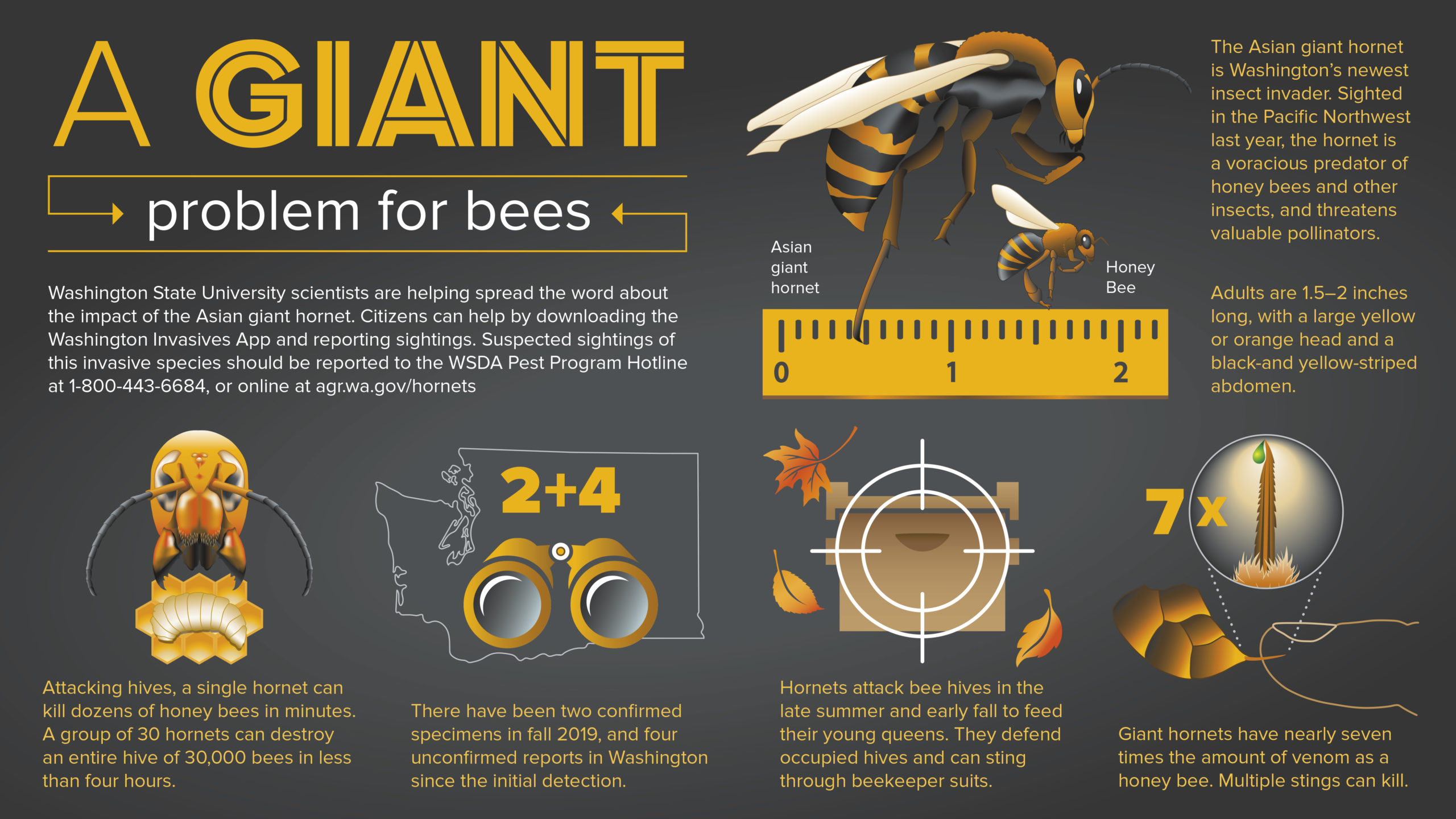Are They Really That Scary?
On April 6, 2020, KHQ released an article titled, “WSU Scientists Researching Possible Re-emergence of Asian Giant Hornets in Washington State.” Not until recently, however, did more media sites begin to focus their attention on the possibility of these enormous insects residing in the states. How big are the hornets? How aggressive are they? Do they pose a serious threat to humans?
What is The Giant Hornet?
The Asiatic Giant Hornet (Vespa Mandarinia) is native to a large portion of Asia and its native habitat stretches from southern Russia through China, India, and the Koreas. Its most commonly-known locale, however, is Japan. Asian Giant Hornets are the largest wasp species in the world. Females are the largest and can grow up to nearly two inches in length. On the Japanese mainland, Asian Giant Hornets are notorious for being very aggressive towards people or animals who wander into the vicinity of their nest.

Some officials say more than 20 people are killed by them each year. These hornets are also highly predatory and actively feed on other insect species, including Honey Bees. The Asian Giant Hornets can wreak havoc on Honeybee populations as only a few hornets can wipe out an entire hive. Sometimes, the Honeybees get the best of the hornets and are able to ‘cook‘ them by covering them and creating friction with their wings.
A Sting That Packs a Punch
Asian Giant Hornets are the largest species of wasp in the world, with a massive stinger to boot. Measuring at roughly a fourth of an inch, the stinger contains a large venom yield. While a zap from an insect this large would undoubtedly make someone scream in pain, how exactly does it hold up when compared to other insects?

In 1983, an entomologist named Justin Schmidt released his first version of the Schmidt Pain Index. Its purpose is to compare the sting pain levels of various insects. Some of the species at the bottom of the list include the Sweat Bee and the Fire Ant. Nearing the top of the list, some of the most painful-stinging insects, according to Schmidt, include the Red Harvester Ant and the Paper Wasp. None of these, according to Schmidt, are as painful as the Bullet Ant of Central and South America. Some insects, however, were not added to the original list, and it has been revised several times.
Braving the Pain Index
Beginning in 2016, YouTuber and founder of Brave Wilderness, Coyote Peterson, embarked on a mission to test the insects of the Schmidt Pain Index. To do this, Peterson used himself as the guinea pig for insect stings. He began at the bottom of the list and worked his way up. He even tested the Cow Killer and Tarantula Hawk, the latter of which he described as almost “paralyzing.” Peterson tested the Bullet Ant, which left him in agony for hours. Having completed the original Schmidt Pain Index, he tested a few others with notorious reputations.
Testing the Giant Hornet
Peterson first sought out the Warrior Wasp, found in Latin America. Though excruciatingly painful, Peterson did not think it topped the Bullet Ant. On November 23, 2018, Peterson traveled to the Tottori Prefecture of Japan. Here, he sought out the Japanese subspecies of the Giant Hornet. After capturing one, Peterson gave a brief overview of the insect before grasping it with tweezers. It did not like being captured and unleashed its wrath. Peterson described the sting as “searing pain.” Not long after, his arm began to swell and he continued to experience immense pain in the hours that followed. According to Peterson, the sting of the Asian Giant Hornet was even more painful than the Bullet Ant.
There are Other Species of Aggressive Bees
While Asian Giant Hornets may be an intimidating newcomer, it is not the first invasive stinging insect to show up on America’s shores. In the 1950s, Africanized Honey Bees were brought to Brazil. Here, they were hybridized with European Honey Bees in an attempt to increase the production of honey. When hybridized, the new strain of bee displayed a type of aggression that was unlike anything seen before.
The bees spread throughout Latin America. By 1990, the bees had established themselves in southern Texas. Today, ‘Killer Bees,’ as they are commonly known, stretch throughout the Sun Belt from California to Florida. According to one map posted by Adkins Bee Removal, they are reported as far north as Washington State in the west and North Carolina in the east, with a lone outlier in Minnesota.
African and European Hornets
While Killer Bees have a reputation for being highly aggressive, some sources suggest their aggression is not consistent. In 2001, biologist Octavio Jaramillo concluded in a study, “after selection of three generations of bees, we concluded that determined AHB (Africanized Honey Bee) family lines could inherit their high levels of tameness, even when they reproduced in the condition of free fecundation (natural mating).”
Aside from Killer Bees, another non-native, invasive stinging insect found in the states is the European Hornet. Often incorrectly referred to as the “Japanese” Hornet, this wasp is found throughout the Eastern and Midwestern US. Though larger than many wasp species, it is smaller than Asian Giant Hornets. According to Pest World, the hornets first arrived in the New York area in the 1800s. While European Hornets can be aggressive, like many species, they will usually leave humans alone if left unbothered.
Exercise Caution Around the Bees
Like the Killer Bee and European Hornet, Asian Giant Hornets can potentially pose a threat to humans. Its very large size, and excruciatingly painful sting, can be enough to intimidate anyone. It can be stressful coping with the possibility of the hornet coming to a locale near you. How should we respond? The best answer is to continue living your life as you normally would. When outside, be alert and aware of your surroundings.
These are not, however, regular honey bees. The Los Angeles Times claims people on the hunt for Asian Giant Hornets have instead found and killed hives of honey bees. If you plan to search for any invasive species, be sure to know how to properly identify the bad from the good. The best bet is to leave this to the professionals.

If you do manage to encounter Asian Giant Hornets, treat them with respect. As is said about other bee and wasp species, refrain from leaving food unattended outside during warm months. If you need a nest removed, call an expert to avoid harming yourself or others nearby. Asian Giant Hornets can be an issue, but the possibility of their presence should not keep you from going outside and living your life. Be cautious, but do not change your life.
- Call of Duty: Modern Warfare 2 (2022) Review - November 9, 2022
- Today In History Spotlights Mar. 13, 1862, The Fugitive Slave Clause is Annulled - March 13, 2022
- Today In History Spotlights Mar. 12, 1947, President Harry Truman Announces the Truman Doctrine - March 12, 2022
JOIN US @NewRightNetwork on our Telegram, Twitter, Facebook Page and Groups, and other social media for instant news updates!
New Right Network depends on your support as a patriot-ran American news network. Donate now

